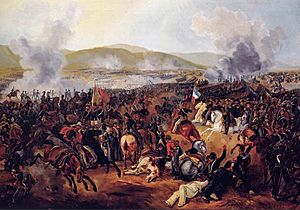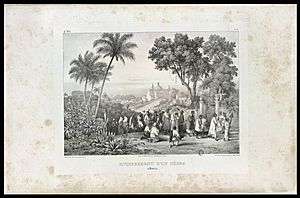Johann Moritz Rugendas facts for kids
Johann Moritz Rugendas (born March 29, 1802 – died May 29, 1858) was a German painter. He became famous in the early 1800s for his paintings of landscapes and people in many countries across the Americas. Many people see Rugendas as one of the most important European artists who visited Latin America. He was inspired by the famous explorer Alexander von Humboldt.
Contents
A Young Artist's Journey
Moritz Rugendas was born in Augsburg, which is now part of Germany. His family had been famous painters and engravers for many generations. He learned drawing and engraving from his father, Johann Lorenz Rugendas II. Later, he studied art at the Academy of Arts in Munich.
Rugendas was inspired by other artists and their travel stories from places like Brazil. He decided to join a science trip to Brazil as an artist. This trip was led by Baron von Langsdorff, who was a Russian official in Brazil. In March 1822, Rugendas arrived in Brazil with other scientists.
As an artist for the trip, Rugendas visited many towns and areas in Brazil, like Minas Gerais and Rio de Janeiro. He drew and painted what he saw. He explored and recorded many details of daily life. He also visited coastal areas like Bahia and Pernambuco before returning to Europe. He mostly created drawings and watercolor paintings during this time.
Sharing His Art with the World
When Rugendas returned to Europe between 1825 and 1828, he lived in Paris, Augsburg, and Munich. He wanted to learn new art skills, like oil painting. During this time, he published a huge book called Voyage Pittoresque dans le Brésil (which means "Picturesque Voyage to Brazil"). This book had more than 500 drawings and was considered a very important record of Brazil in the 1800s.
Rugendas was still inspired by Alexander Humboldt, who was a famous explorer. Rugendas wanted to create a bigger art project. He wanted to draw and paint the nature and life of all of Latin America. He called it "an endeavor to truly become the illustrator of life in the New World".
In 1831, he first traveled to Haiti and then to Mexico. In Mexico, he made drawings and watercolors of places like Morelia and Teotihuacan. He also started to paint with oils, and his work was excellent. However, he got involved in a political problem and was sent out of Mexico in 1834.
From 1834 to 1844, he traveled to many other countries, including Chile, Argentina, Uruguay, Peru, and Bolivia. Finally, in 1845, he returned to Rio de Janeiro, Brazil. The Emperor of Brazil, Dom Pedro II, welcomed him. Rugendas painted pictures of people from the royal family and showed his art in an exhibition. In 1846, when he was 44 years old, Rugendas went back to Europe for good.
Painting People in Brazil
From 1822 to 1825, Rugendas painted many black people living in Brazil. He was part of an art style called "tropical romanticism." This style showed places like Brazil as a peaceful mix of different races and cultures.
Rugendas's paintings often showed black people from different backgrounds. He paid close attention to their hairstyles, jewelry, and even scars. This was because he wanted to show the different groups of people. For example, in some of his prints, he would show several faces of men and women. He did this to compare how different groups looked. He sometimes showed people with marks or without clothes to suggest they were "less civilized." But he showed people born in Brazil wearing clothes and jewelry, as if they were more "civilized" than those from Africa. Rugendas even said that black people born in Brazil were more polite and kind than those from Africa.
Rugendas also painted black people doing everyday activities. These paintings showed them working in cities, like selling things in the streets, carrying water, or doing laundry. In these scenes, he focused more on the activity and the place, rather than showing small differences between people. He believed that work helped black people grow and improve their lives.
Rugendas was influenced by Alexander von Humboldt's ideas. He thought that where people lived affected how they developed. He believed that a lack of formal education in Africa made the African race seem "inferior" to him. However, Humboldt was against slavery, and Rugendas also disliked the slavery system in Brazil. He supported ending slavery slowly, step by step.
Some historians say that Rugendas's art had a political message. He supported a Christian way of ending slavery slowly. Even though he wanted slavery to end gradually, he also believed that slavery in Brazil gave Africans a chance to learn about Christianity. In some of his paintings, like Enterro de um Negro na Bahia (Burial of a Black Man in Bahia), he showed a dead black man with a suffering Christ figure. This connected the black man's suffering to religious ideas. Other paintings, like Mercado de Negros (Slave Market), showed churches in the background. Familia de Agricultores (Family of Farmers) was one of the few paintings where he showed black people in private homes, often as slaves or servants to white families.
The art of foreign painters like Rugendas helped shape how people thought about race in Brazil in the 1800s. Their romantic view of slavery, seeing it as a way to "civilize" people, helped create the idea of "racial democracy." This idea suggested that all races lived together in harmony in Brazil. Rugendas's images were published in books and helped spread this idea both inside and outside Brazil.
Later Life and Legacy
Moritz Rugendas died on May 29, 1858, in Weilheim an der Teck, Germany. The King of Bavaria, King Maximilian II, bought most of his artworks. In return, Rugendas received money for the rest of his life. One of his famous paintings, Columbus Taking Possession of the New World (painted in 1855), can be seen at the Neue Pinakothek museum in Munich.
See also
 In Spanish: Mauricio Rugendas para niños
In Spanish: Mauricio Rugendas para niños
- Ludwig Riedel
- Francis de Castelnau
- Sigismund Ernst Richard Krone
- Peter Claussen
- Jean-Batiste Debret
- François-August Biard









